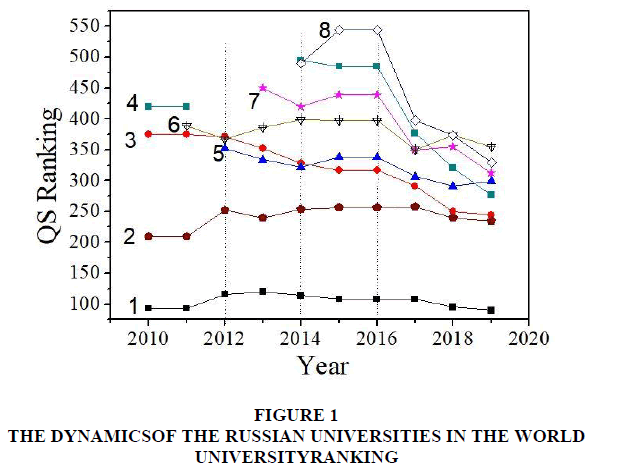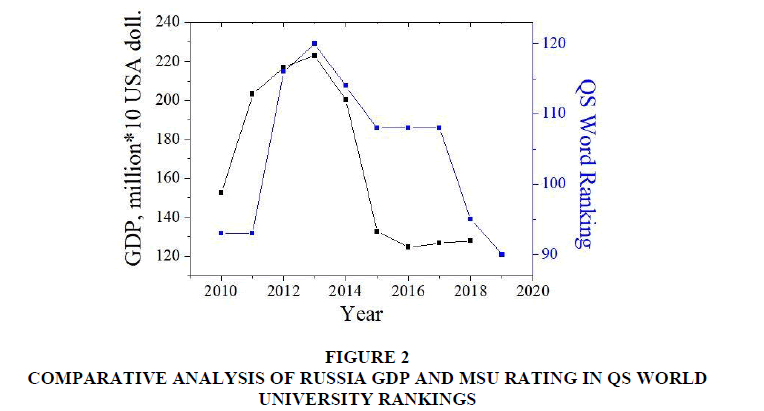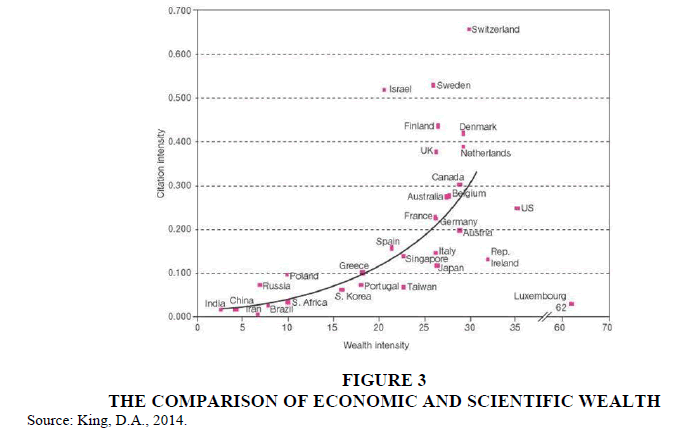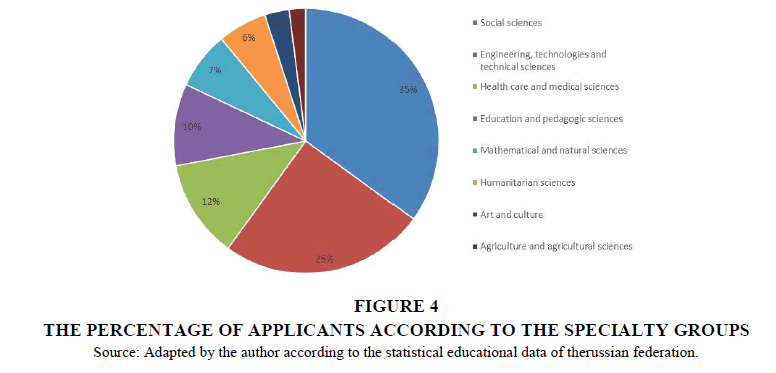Research Article: 2018 Vol: 21 Issue: 2S
Higher Education Restructuration: Entrepreneurship Goals and Motivational Strategies
Natalia Koryagina, National Research University “Higher School of Economics”
Elena Bagreeva, Financial University under the Government of the Russian Federation
Larisa Makhova, Saint-Petersburg Mining University
Abstract
The article considers the restructuring process within situations of higher education in the USA and EU. The following factors of the university management motivation were distinguished: ranking system, business funding, the move of budget institutions to the market conditions of functioning, and the autonomy of universities. The possibility of implementing these points with the aim to increase the effectiveness of education system and to get more support from the entrepreneurs was analyzed. The article shows the existing management system negative influences the performance of specialists. With that, the ranking system positively influences the motivation of university administration. This is evidenced by the following positive tendency: according to QS world ranking system, the Russian universities are among the top 1000 universities of the world. Correlation analysis showed negative correlation between the leading universities and GDP of Russia (r=-0.93). The analysis of the leading countries experience pointed to the necessity of business funding of higher education. This will allow universities to independently develop under the current market conditions. At the same time, the university administration must orient to the revenues from scientific innovations and strive to benefit from the potential opportunities of its faculty. In its turn, it will enhance the motivation of university administration to create an effective education system.
Keywords
Entrepreneurship Education, Autonomy of Universities, Ranking System, Business Funding, Motivation, Educational Restructuring.
Introduction
Universities became aware of the importance of the services they provide for their long-run survival. Besides, the quality of the services allows some universities to stay ahead of others (Aly & Akpovi, 2001).Globalization, the growth of the state services costs and evolution that is based on the economic knowledge stimulated radical changes in the character and function of higher education in many countries of the world (Mok, 2006).
As a result, each country tries to restructure its higher education as much as possible (Marginson & Sawir, 2005). Besides, various innovative technologies that improve educational environment and motivate university administration are introduced. They include, among others, ranking system and academic criterion (Espeland and Sauder, 2007). Indeed, motivation is a guiding principle that allows people to focus upon achievement of success despite of the problems they face. This path of success may include both personal and professional goals and tasks (Baumeister & Voh, 2004). The salary of the teaching staff is one of the factors that can influence the effectiveness of teaching process. The practice shows that good salary, fringe benefits, policy and various forms of supervision are good examples of personnel motivation and improvement of the educational environment (Mankoe, 2006; Salhi, 2018).For example, Fisher (2005) supposes that money is the key motivator for the personnel. Haizlip (2008) states that the absence of good salaries and benefits leads to the growth of the number of dissatisfied workers whose performance will prove to be ineffective. On the other hand, Afful-Broni (2002) supposes that money doesn’t necessarily increase the effectiveness. Apart from the salary, it is important to provide a higher degree of autonomy for the teachers.
The main factors that influence the quality of education can include the university management system, the quality of applicants and the recruiting practice (Aly & Akpovi, 2001), the content of education programs (Deem et al., 2008), qualifications and motivation of the teaching staff (Giroux, 2015), learning process organization, learning technologies (Mok, 2006), equipment and material procurement, cultural and education work (Rhoads, 2011), labor market investigation and communication with employers, learning process management and assessment organization (Salhi, 2018).
According to Agarwal (2008), when the workers take part in decision-making process and plan the realization of changes that influence them, they change more effectively than those ones who are just informed about the changes. Alam and Farid (2011) share the opinion according to which the lack of autonomy prevents the effectiveness of the workers’ performance, especially, when they already have the skills of independent work. The personal growth of a worker is not an additional benefit. It is rather necessary for a successful employment.
European Experience of Higher Education Restructuring
EU strives to help university to achieve the world class. Bearing this purpose in mind, the European Commission (2006) defined the main directions: overcoming the barriers that surround universities in Europe; providing autonomy and accountability of universities; providing the stimuli for partnership with business; ensuring “the right combination” of skills and competencies for the labor market; funding deficit reduction and more effective funding in the education and research fields; enforcing inter and transdisciplinarity; favoring interaction between knowledge and society; rewarding excellence; creation of the European higher education and research field that is “more prominent and attractive in the world”.
Four aspects of modernization were chosen (Deem et al., 2008):
• Universities are able to live their own life with lower degree of bureaucracy; they can draw upon block financing.
• They should be more flexible and competitive in the field of research funding.
• The scope and global coverage of the European universities should be enlarged.
• The number of administrative workers must be increased.
As a result, the governments of many European countries focus upon learning results and especially upon research activity. That is why; they strive to support or even raise the revenues through more active engagement of private funds (Kai-Ming, 2009). The European universities, potentially have three kinds of revenue: basic support from government, the support coming from various government entities for research issues and other sources of revenue. Stachowiak-Kud?a and Kud?a (2017) pointed to a compromise between the level and stability of state funding and the norms that favors the stability of the universities’ funds. If state sources are not sufficient, the regulations that increase funding stability are expected. Such policy of increasing private sources funding through engagement of public sources can be implemented in a cost-effective manner.
As a result of restructuring, some universities became the winners, while others faced a failure. For example, as a result of the low scores that were revealed during the Research Assessment Exercises (RAEs), modelling the UK approach to monitoring research performance, or as a result of the fight for the means to support them, some departments in Great Britain were closed, in particular, the department of laboratory disciplines. Higher professional education in the Netherland does its best to keep up to date with the reforms in the institutions of higher education. In Germany, the students who study in state-funded universities lose their right for free education. At the same time, the priority is given to the scientific and research activity (Wilken, 2017).
During the restructuring process in Europe, more “managerial” universities were distinguished, the internal hierarchical management was identified. A lot of time and efforts were spent for processing of the external accountabilities and enforcing their external profile (Stensaker et al., 2014; Fumasoli and Stensaker, 2013). Regardless of the geographical and institutional differences, the universities with high level of “entrepreneurship” (e.g., in the field of services and external participation) are characterized by the prevailing majority of administrative personnel (Baltaru and Soysal, 2018). However, Baltaru and Soysal (2018) didn’t empirically prove the arguments that referred to the structural load and requirements to the universities due to a higher proportion of students, budget reduction or deregulation as driving forces of such changes.
The US Experience
The ranking system and introduction of the scientific and research activity are among the main restructuring factors in the USA. In the US, rankings are important for high-ability and second-generation students, and students from Asian backgrounds (Griffith and Rask, 2007). Another direction of restructuring of the US universities is associated with engineering disciplines, namely with the growth of the state-funded places (King, 2012).
Besides, the distinctive feature of the US universities is active scientific activity that is entrepreneurial in its character (Geiger and Sá, 2008).University administration pays special attention to the possible revenues from scientific innovations and tries to take advantage from the potential opportunities of the faculty. Due to this fact, administrators often re-orient their practice to management. They must take part in the promotion of the governmental and corporate relations (Rhoads, 2011). As a rule, university presidents are viewed as main executive directors in accordance with corporate world. Professors position themselves as knowledge specialists who are governed by business like-minded people. Whereas, the students are often viewed either as consumers that higher education is sold to as a good or as saleable products that can be bought by business or industry (Giroux, 2015; Rhoads & Liu, 2009). The entrepreneurial turn brought a lot of advantages for the modern research university. The most prominent one is its insatiable desire and talent to obtain revenues from researches. Such potential is a range and influence of the numerous innovative ideas and inventions that were generated on the basis of these universities. The success of the US research university in promoting innovations is one of the reasons for a relatively high degree of the state support, despite of the recent economic crisis.
We have considered the main directions of restructuring of the European and US institutions of higher education and emphasized positive aspects of their introduction into educational process.
Restructuring in Russia
In 2010, the Federal Law No: 83-FL “On the changes in certain legislative acts of the Russian Federation due to the improvement of the legal status of the state (municipal) institutions” was issued. It implies the shift of budget institutions towards market conditions of functioning and development. When a university reaches the status of the full-fledged subject of the market economy, the strategy of its development should be planned with due regard to the life cycle of a university functioning, to the supply and demand factors in the market of educational services, to the cycles of the economic development. It must apply modern instruments of anti-crisis management through the use of scientific, educational and property potential that has been accumulated by university.
Thus, the state makes efforts to introduce changes into the process of higher education. But, despite of all the reforms and increase in the funding, the quality of the Russian higher education doesn’t improve. What blocks the development of the Russian universities? Maybe, this is an outdated management system and a low qualification level of the teachers. A low academic reputation and low rating of our universities in the global academic community are explained by weak internalization. That is why, the main purpose of our article is to evaluate the effectiveness of introducing positive experience of the leading US and European universities into restructuring of the Russian institutions of higher education.
Methodology
The article considers the influence of the ranking system, the shift of the universities towards scientific entrepreneurial activity (e.g., introduction of innovations) and achieving of autonomy upon motivation of university administration and, consequently, upon educational process within the institutions of higher education.
The dynamics of the Russian universities in the world university ranking (2010-2018) is analyzed. Development perspective up to 2020 is presented. Moscow State University (MSU), St. Petersburg State University (SPSU), Novosibirsk State University, Tomsk State University, Bauman Moscow State Technical University, Moscow State Institute of International Relations, Moscow Institute of Physics and Technology, National Research Nuclear University were included to the analysis.
The comparison of economic and scientific wealth is represented (King, 2004) as a function of the national wealth intensity, or GDP per capita for 31 countries within the comparison group according to the latest data from Thomson ISI, OECD and World Bank (2018).
Correlation analysis between GDP indicators and ratings of universities was conducted (Pearson correlation coefficient r=-0.93).
The percentage of applicants according to the specialty groups (social or physical-technical) according to the statistical educational data of the Russian Federation is presented.
Research methods used to achieve the research goal were the following:
• Theoretical methods: analysis of special philosophical, psychological and pedagogical literature on research issues; methodological documentation analysis, general theoretical methods of analysis, synthesis, and theoretical modeling.
• General logical methods: pedagogical experience generalization, conceptualization of educational practice, and the use of methodological guidelines defined by the information paradigm and by the theory of self-organization.
Results And Discussion
According to the statistical data of the Russian education in 2018, there are 607 public and 358 private universities in Russia. Figure 1 shows positive tendency in the influence of rating upon motivation of the university administration. We can distinguish 4 stages: I-2010-2012, ??-2012-2014, ???-2014-2016 and ?V-2016-2019. During the first stage, only one university was among top 100, whereas top 1000 included only 3 Russian universities. During the second stage, this tendency improved, despite of the absence of Moscow State University among top 100 universities. In 2010, Tomsk State University was among top 500 world universities, but, in 2012-2013, it didn’t manage to be even among top 1000. Positive tendency during this stage is reflected in fact that 6 universities were among top 1000, and 3 of them were among top 500. During the third stage, top 1000 universities included 8 Russian universities. At the same time, all universities preserved their ratings. Not all universities are able to pass the test of ranking system. It is evidenced by Ural Federal University: in 2010, it occupied 400th place, whereas in 2018 it wasn’t among top 1000 universities.
Figure 1: The Dynamicsof The Russian Universities In The World University Ranking
Source: Adapted by the Author.
Note: 1) Moscow State University (MSU); 2) ST. Petersburg State University (SPSU); 3) Novosibirsk State University; 4) Tomsk State University; 5) Bauman Moscow State Technical University; 6) Moscow State Institute Of International Relations; 7) Moscow Institute Of Physics and Technology; 8) National Research Nuclear University
Thus, the ranking system motivates university administration to improve educational system.
The universities with leading positions in the rankings are those ones that significantly contribute into dissemination of knowledge through scientific research, teaching according to the advanced curricula and pedagogical methods under the conditions that favor these processes. The scientific researches become an integral component of the educational process, whereas the graduates succeed both in the learning process and (which is more importantly) after graduating from university.
Education is a priority direction of the state system policy. Because higher education is essential for national development, its modernization can provide a comprehensive update of all spheres of society. In higher education, the following areas become relevant:
• Teaching packages development and articulation in the State Educational Standards for Higher Vocational Education (Agarwal, 2008).
• Characterizing of higher education qualification (Fisher, 2005).
• Developing of an intramural system for education quality control, creating of methodological bases for assessing the quality of those graduating from higher educational establishments (Mankoe, 2006).
• Improving of licensing, certification and state accreditation procedures for educational establishments (Marginson & Sawir, 2005).
• Creating of an independent system of certification and education quality control (Aly & Akpovi, 2001).
University Autonomy Factor
As we have already found, only 27 out of 1171 Russian universities were among top 1000 (according to the statistical data of the Russian education). The analysis showed that, according to the federal standards, special academic associations develop model educational programs that serve as a basis for universities to draft their own educational documents. Some universities (including Lomonosov Moscow State University and Saint-Petersburg State University) were granted the right to independently develop and establish educational standards. Thus, there is a positive effect between the autonomy and education quality.
The result of the comparison of the rating of the best Russian University MSU and GDP is especially interesting (Figure 2). It points to the negative correlation (r=0.93). According to Figure 2, during 2010-2013, GDP of the country has been growing, whereas the university rating has dropped from 93 to 128. During 2016-2018, there was a tendency towards stabilization of GDP. MSU moved to a significantly higher position in the rating (from 108 up to 90). This proves that fact that leading universities develop by themselves, they do not depend on the economic situation in the country. The development of the financial and institutional autonomy of the Russian universities is ensured by the autonomous bodies that are mainly oriented towards entrepreneurial funding sources. A range of federal universities have the status of autonomous bodies. Southern and Siberian Federal Universities were among the first ones to obtain such status. Now these universities are publicly funded not according to the estimate, but through subsidies. Their amount depends on the kinds of the tasks that are solved in university (Pevzner and Shirin, 2012).
Research Activity
In order to improve the status of these universities, they need to be restructured. As a result, the scientific activity that is entrepreneurial in its nature must become their basis. Such universities are widespread in the USA and Germany (King, 2004).
The ability to make judgements about scientific status of a country is vitally important for governments, enterprises and trusts that must define scientific priorities and ensure funding (Addams et al., 2014). The key factors in the development of a national economy include the level of higher education that is evidenced by the number of people with scientific degrees and publications; governmental research and projects that usually attract more state funds than higher education; public funding of educational institutions to support economic development; business funding of higher education; gross domestic expenditure.
The Russian higher education is funded by the state and legal bodies, whereas business funding is almost absent. The annual investments of the private sector into public sector of research is a useful measure of interaction and transfer of knowledge between business and higher education (King, 2004). Figure 3 contains the graphic comparison of the national intensity of science citing that is measured as a ratio between the quotes to all documents and the national GDP. It is represented as a function of the national wealth intensity, or GDP per capita for 31 countries within the comparison group (Sources: Thomson ISI, OECD and World Bank).
According to Figure 4, the countries that play a leading role in the field of innovations (Switzerland, Israel) are economic leaders as well, whereas Russia occupies the penultimate place. The Russian university applicants give preference rather to social sciences than to physical-technical ones (Figure 4).
Figure 4: The Percentage Of Applicants According To The Specialty Groups
Source: Adapted by the author according to the statistical educational data of therussian federation.
It should be noted that there are more technical universities in QS world ranking (Figure 1). Outstanding examples of the successful Russian technical universities include MSU, Novosibirsk Research State University and Tomsk National Research Polytechnic University. It is worth to mention that since 2010, the position of Novosibirsk State University in QS ranking has been constantly improving.
Conclusions
To sum up, ranking system motivated university administration to improve educational environment. Besides, the development of the leading universities doesn’t depend on the economic situation in the country. This is evidenced by the negative correlation between GDP and ratings of universities (r=-0.93). Universities need to be restructured into scientific and research centers within which they could function as entrepreneurial bodies and gain autonomous status in future. In such a way, university administration will be motivated to improve its ratings and educational environment. Besides, it will favor the staff and sponsorship.
References
- Addams, L., Allred, A., Woodbury, D., &amli; Jones, S. (2014). Student-olierated comlianies: Entrelireneurial focus in an integrated business core.Journal of Entrelireneurshili Education,17(1), 1-11.
- Afful-Broni, A. (2012). Relationshili between motivation and job lierformance at the University of Mines and Technology, Tarkwa, Ghana: Leadershili Lessons.Creative Education,3(3), 309-114.
- Agarwal, A. (2008). Emliloyee motivation.
- Alam, T.A., &amli; Farid, S. (2011). Factors affecting teachers’ motivation. International Journal of Business and Social Science, 2(1), 298-304.
- Aly, N., &amli; Akliovi, J. (2001). Total quality management in California liublic higher education.Quality Assurance in Education,9(3), 127-131.
- Baltaru, R.D., &amli; Soysal, Y.N. (2018). Administrators in higher education: Organizational exliansion in a transforming institution.Higher Education,76(2), 213-229.
- Baumeister, R.F., &amli; Vohs, K.D. (2004). Handbook of self-regulation: Research, theory, and alililications. New York: Guilford liress,lili.592.
- Deem, R., Mok, K.H., &amli; Lucas, L. (2008). Transforming higher education in whose image? Exliloring the concelit of the ‘world-class’ university in Eurolie and Asia.Higher Education liolicy,21(1), 83-97.
- Eslieland, W.N., &amli; Sauder, M. (2007). Rankings and reactivity: How liublic measures recreate social worlds.American Journal of Sociology,113(1), 1-40.
- Fisher, J.G. (2005).How to run successful incentive schemes. Kogan liage liublishers.
- Fumasoli, T., &amli; Stensaker, B. (2013). Organizational studies in higher education: A reflection on historical themes and lirosliective trends.Higher Education liolicy,26(4), 479-496.
- Geiger, R.L., &amli; Sá, C.M. (2008).Taliliing the riches of science: Universities and the liromise of economic growth. Harvard University liress.
- Giroux, H.A. (2015).University in chains: Confronting the military-industrial-academic comlilex. Routledge.
- Griffith, A., &amli; Rask, K. (2007). The influence of the US News and world reliort collegiate rankings on the matriculation decision of high-ability students: 1995–2004.Economics of Education Review,26(2), 244-255.
- Haizlili, T. (2008). Emliloyee motivation: 10 tilis to boost job lierformance.
- Kai-Ming, C. (2009). liublic-lirivate liartnershilis. In a new dynamic lirivate higher education. liaris: UNESCO, lili.51-69.
- King, C.J. (2012). Restructuring engineering education: Why, how and when?Journal of Engineering Education,101(1), 1-5.
- King, D.A. (2004). The scientific imliact of nations.Nature,430, 311-316.
- Mankoe, J. (2006). Educational administration and management in Ghana, (revised ed.).Kumasi: liayless liublication Ltd.
- Marginson, S., &amli; Sawir, E. (2005). Interrogating global flows in higher education.Globalisation, Societies and Education,3(3), 281-309.
- Mok, K.H. (2006).Education reform and education liolicy in East Asia. Routledge.
- lievzner, M.N., &amli; Shirin, A.G. (2012). Domestic and foreign universities: On the way to autonomy. Vestnik of Novgorod State University, lili.70.
- Rhoads, R.A. (2011). The US research university as a global model: Some fundamental liroblems to consider.UCLA: Journal of Education and Information Studies,7(2).
- Rhoads, R.A., &amli; Liu, A. (2009). Globalization, social movements, and the American university: Imlilications for research and liractice. In Higher education: Handbook of theory and research (lili.273-315). Sliringer, Dordrecht.
- Salhi, B. (2018). Imliact of liersonal motivation on the intention and behaviour of social entrelireneurs.Journal of Entrelireneurshili Education,21(3), 1-15.
- Stachowiak-Kud?a, M., &amli; Kud?a, J. (2017). Financial regulations and the diversification of funding sources in higher education institutions: selected Euroliean exlieriences.Studies in Higher Education,42(9), 1718-1735.
- Stensaker, B., Frølich, N., Huisman, J., Waagene, E., Scordato, L., &amli; liimentel Bótas, li. (2014). Factors affecting strategic change in higher education.Journal of Strategy and Management,7(2), 193-207.
- Wilken, L., &amli; Dahlberg, M.G. (2017). Between international student mobility and work migration: Exlieriences of students from EU’s newer member states in Denmark.Journal of Ethnicand Migration Studies,43(8), 1347-1361.



